I was warned that the flies I needed should be tied or purchased
before I got to Belize. I wouldn't think about buying flies I could
tie myself, but for anyone considering a trip of this sort, be warned,
the flies you need will cost a small fortune if you wait to buy them at
a lodge on an isolated island somewhere. Also be warned; the flies
you need will change in size and color depending on where in the
world you fish.
I searched a lot of places for information on what flies to take and what
colors and sizes they needed to be tied in. John Goplin (my Scientific Anglers
rep) warned me that they should be small (sizes 6 & 8) and should be slanted
towards the tan and pink colors. Visits to at least a dozen web sites for
lodges in Belize confirmed the sizes and hinted that the colors he suggested
were right. I had already tied a lot of larger flies (2 & 4) in white and
chartreuse because they were suggested by guides in Florida and people
who had fished the Bahamas. I took those along to be safe. In fact, I tied
more than three hundred bonefish flies in all sorts of colors and patterns.
I was also warned by several sources that some of my flies needed to be
un-weighted or at least very lightly weighted for the flats that are sometimes
only inches deep. That was good advice. Some of the flats in Belize are
less than 10 inches deep and the bonefish move into those flats to feed.
Weighted flies will often scare the fish when they hit the water, but un-weighted
flies don't hit the water as hard and don't scare the fish as often.
I also tied flies for permit and tarpon. We'll look at those types of flies and
discuss what they represent to the fish. After fishing there, I firmly believe
there's room for improvement in some of the patterns used on these species.
I'm already working on a design for a new permit fly that will look different
than anything I've seen in any book or web site. You'll also get a look at
a new bonefish fly that was the hot fly of the trip.
Let's take a look at the flies and discuss what they're supposed to represent
to the fish. A discussion on what I think triggers a feeding response in the fish
with each of these flies is also in order here. It was looking at that trigger
response and what these flies had in common that prompted me to create
that new fly that was a huge success this trip.
Bonefish Flies
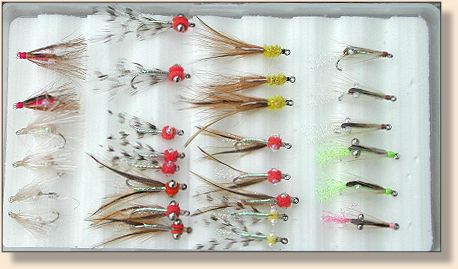
Perhaps the most popular and widely used bonefish pattern is called a
Crazy Charlie. The funny thing about this pattern is that it seems to be
tied in dozens of colors and hundreds of variations. I've been told that
it's supposed to represent a shrimp, but I think some of the colors and
several of the ways I've seen it tied suggest other things like maybe
anchovies. The most popular color I saw in Belize seemed to be pink,
followed by tan, white and chartreuse. If I go again, I'll add orange
to that list.
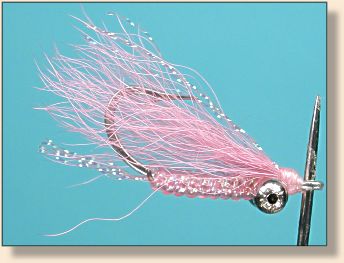
The bodies of my Crazy Charlies were created by wrapping pearl tinsel
over the colored thread used to tie the fly. V-Rib was then wrapped over
the tinsel right up to the bead chain eyes. A hint of the thread color passed
through the tinsel and V-Rib to give the body the color I wanted. I also
used colored tinsel on several flies and pink V-Rib on several of the pink
patterns to provide color choices for the fish. I varied a few of the flies
by adding a few strands of crystal flash as a tail. Some people use heavy
monofilament in the place of the V-Rib and others don't wrap anything
over the tinsel body.
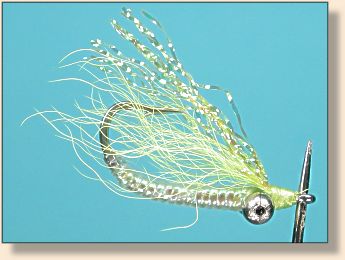
The wing of most Crazy Charlie flies is made of calf tail hair in various colors
(often colors that match the body) and a few strands of crystal flash in colors
to match the hair. Variations I saw while researching this fly were endless.
It seems people use anything from antron and craft fur to fox tail for wing
materials. Some people tie their wings full and long while others tie them
sparse and short. I think I did a little of both. I also varied the weight from
small pearl craft beads (virtually no weight, but the right look) to medium
sized bead chain eyes. Depending on the depth of the water, you might
need several weights.
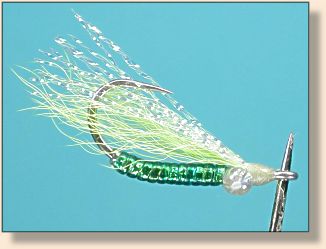
I noticed several things all the Crazy Charlie patterns had in common.
The bodies need to be tied to reflect light in a manner that makes the
body almost glow. That seems to be a visual trigger for feeding fish
that is common to all flies of this type. The other thing they all had in
common was some type of flashy material added to the wing. Crystal
flash was the most common flashy material added to wings. Another
flashy trigger to attract the attention of feeding fish.
Another common bonefish pattern is something called a Gotcha. It seems
everyone has their own version of this fly (I read at least 50 variations of
this pattern), but the most common trait is that this fly is similar to a Crazy
Charlie. The biggest difference between a Gotcha and a Charlie seems
to be the crystal flash tail and the longer wing that is usually synthetic hair.
Usually is a pretty strong word here. The wings varied in recipes I saw in
books and on the internet from craft fur and macramé yarn to arctic fox tail
hair (AK Best's pattern). There was just as much variation in the body
and tail as there was in the wing. However, they all had a few common traits.
They use the same flashy "trigger" mechanisms in the body and wing as the
Crazy Charlies use.
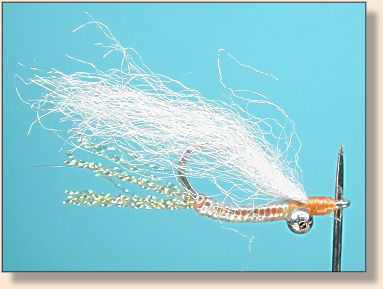
You'll find dozens of other patterns that look like variations of a Crazy Charlie.
The Christmas Island Special is one of many. Bead eyes up front, a body
that almost glows and a wing of some sort that has some flash in it are the
common traits. Take your pick on the colors with pink, white, chartreuse
and tan leading the way. Sizes for all these flies will range from 2 and 4
in northern places like Florida and maybe 4 and 6 in the Bahamas to 6, 8
and even 10 in Belize.
Flies called Puffs and Horrors are suggested offerings on many of the web
sites and in most of the pattern books I read. Just looking at the way they
are tied leads me to believe they are just as likely to imitate a small minnow
as a shrimp. This look might turn you off, but suggestive patterns are often
the best flies.
Puffs have a tinsel body and a wing composed of usually brown or grizzly
hackle feathers and crystal flash. They also have pink, orange or yellow
chenille wrapped in a figure-8 manner around the bead chain eyes. That's
the usual configuration with dozens of variations across the internet and
in books.
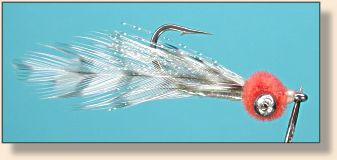
Horrors are similar to puffs except they don't usually have bead chain eyes
and about half the time they don't have anything wrapped around the hook
to form a body. Yellow is the most common color of the chenille wrapped
around the front of the hook.
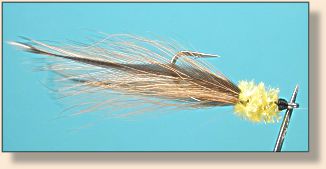
If you feel you aren't getting exact patterns here, you're right. That's because
there doesn't seem to be any exact way to tie these flies. Even pattern books
and fly companies vary a lot in the way they tie and show the patterns. They
have common characteristics, but they vary a lot depending on where you
look for information.
Clouser minnows are considered a good bonefish pattern. The color selection
here is just about anything you want to use, but mostly colors that relate to the
colors you would tie a Crazy Charlie. For Belize, small and little weight would
be the rule. I tied a small selection of Clouser Minnows for this trip, but the
guides didn't mention them and neither did most of the web sites I visited
while preparing for this trip. I doubt they quit working; maybe just feel
out of grace or work better elsewhere?
Shade is probably more important than most people think, and the same holds
true for fresh water as it does for saltwater. The standard rule of thumb is
lighter patterns over lighter bottoms and darker patterns over darker bottoms
(like over weeds, etc.). We broke the rules many times successfully; but the
rule is probably a good one anywhere, and may be critical in other locations.
There are many other bonefish patterns that are either variations of the same
stuff I've described or are harder to tie (like the Bonefish Bitters). I can't
cover them all and I won't try. These are the standard patterns (and I use
that term loosely) that I tied for my trip. I didn't use all of them because
there was something in my fly box that seemed to be just what the bonefish
wanted, and I'm not one to argue with success.
The hot fly on this trip to Belize was one of my own patterns called Al's Shrimpf.
It's easy to tie and (to my eye) looks closer to a shrimp than any of the other
patterns I saw. Those of you who know me or have followed my writing for
a while can guess that it's derived from my Shwapf pattern, and you're right.
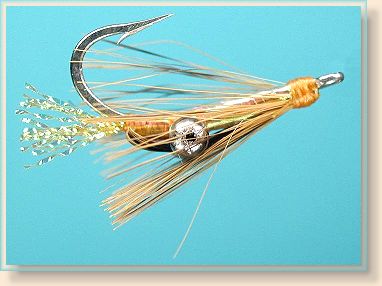
I won't go into the details of tying the Shrimpf here. You can read the steps and
follow the pictures in the Fly of the Week
column here on FAOL. However, I would like to describe some of the features of this fly.
I started developing the Shrimpf by trying to design a Shwapf for saltwater,
but it just didn't look quite right.
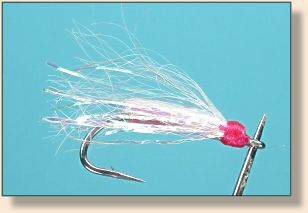
I'm glad I didn't tie up too many Shwapfs for Belize because the bonefish
didn't like them. However, the snapper took to them well. I think snapper
must be the bluegill of the ocean; they hang around docks and will hit
almost anything you throw at them.
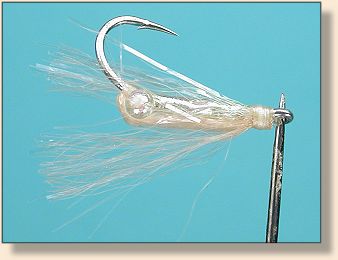
My next variation was something I call a Ghost Shrimpf. I didn't even try it
on bonefish but a local guy is already catching trout on it in several of the
local lakes. I didn't try it in Belize because it didn't fit the mental picture
of what I wanted in a bonefish fly.
The final version of Al's Shrimpf has crystal flash for a tail (vary the color as
desired), and bead chain or craft bead eyes set near the bend of the hook
(vary the weight of the eyes to fit the water your fishing). It has a pearlescent
tinsel body, and either squirrel or badger hair flared back around the body
for a distinct profile. However, before the hair is flared around the body it's
pulled between the eyes to add depth to the body.
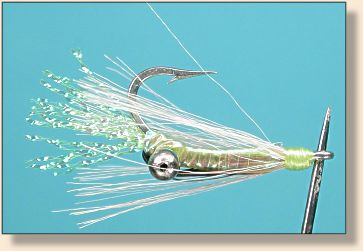
The thread and crystal flash colors can vary, but should match each other.
Those colors will glow through the tinsel body to give the fly a glowing
color that can't be matched any other way I tried. Alternating between
fox squirrel hair and badger hair will give you lighter and darker flies to
match the appetites of the fish. I tied a variety in three weights, three
sizes of each weight and squirrel and badger hair versions of each.
I tied four of each variation in seven colors.
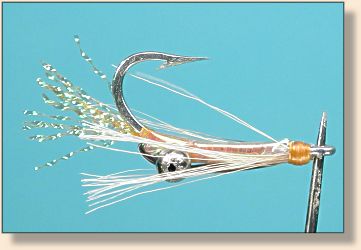
The best Shrimpf colors seemed to be orange & squirrel, orange & badger,
pink & squirrel, pink & badger and tan & badger. Other colors that
worked well are chartreuse & badger, chartreuse & squirrel, pearl & squirrel,
pearl & badger, tan & squirrel and light red & squirrel. Depending on the
depth of the water, different weights worked best. In thin water the pearl
craft beads worked best for eyes, but deeper water called for small to
medium bead chain eyes.
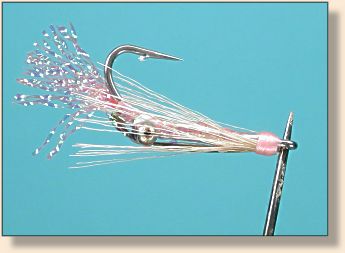
The vast majority of the fish our group caught were on my Shrimpf flies.
The guides liked them too. Several people in our group caught jacks on
Shrimpf flies as well. If you're going for bonefish any time soon, you
should tie some of these flies for your trip. If you don't tie your own,
there are many capable tiers here who can tie them for you (Thomas
Duncan aka pastortd in the chat room and on the bulletin board is tying
them commercially now). I'm sure there'll be more places to buy them soon.

Permit Flies
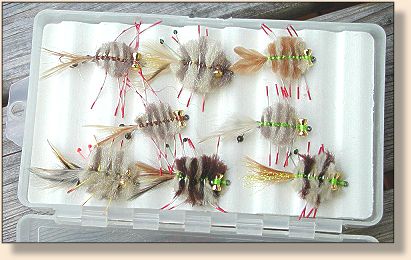
Permit flies seem to be mostly designed to look like crabs. Since crabs
are a favorite meal of theirs, I can understand why that's the case. However,
shrimp are also on their menu and few permit flies look like shrimp. I'm
guessing some people use bonefish patterns on these fickle fish as well.
Most patterns involve a variation of yarn bodies trimmed to the shape of a
crab, velcro bodies with legs and furry foam bodies with legs. Standard
patterns are light to medium in shade and stay pretty close to tan for a
color. Del's Merkin seems to be the overall favorite pattern with the
guides I met.
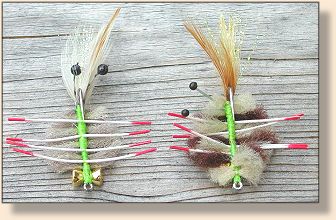
Permit are fickle fish that are hard to catch. Our group didn't get a bite
the day we chased these fish, so I don't have any success patterns to
describe to you. I did get a couple of follows, but they always turned
away without hitting the fly. I tried every fly in my crab fly box and
every fly the guide had without even a nibble. The others did the same
with the same results. Tough fish!
In retrospect, I wonder if a fly that looks like a cross between a shrimp
and a crab will work better? I'm working on that pattern now and will
be looking for a couple of people to test them on permit in the future
unless I'm lucky enough to get to test them myself. Keep in mind that
the crabs these fish eat in Belize have a body about the size of a nickel
or quarter, so size your flies accordingly.
Tarpon Flies
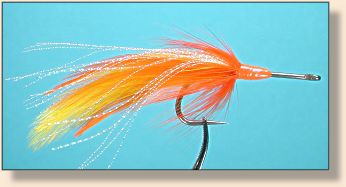
According to the web sites for many of the lodges in Belize, Stu Apte style
flies are the preferred pattern. These flies are tied back on the hook leaving
a bare shank behind the hook eye. This bare area on the hook shank is
where you attach your leader with a snell knot. Colors vary widely with
light and dark being the determining factor in which fly to use.
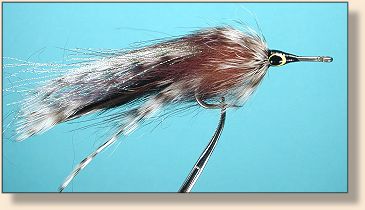
According to what I've been told, these flies are supposed to represent
minnows or other small fish. I think they look more like squid. Common
characteristics of these flies are hackle tails with crystal flash added for an
attracting flash, and either hair or hackle flared back from the front around
the forward part of the fly. Big heads (with or without eyes), are common.
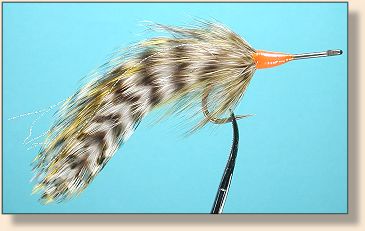
Some of the tarpon patterns I discovered in books and on the internet use
synthetic materials in the tail either with hackles or without. Deceiver
patterns and similar flies are also listed as tarpon patterns. I'm guessing
this is a case of presentation being 80% and pattern being less than 20%
of the equation. Light and dark shades seem to be more important than
pattern; at least they were to our guides.
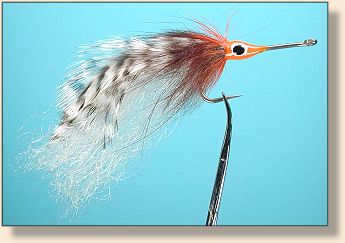
I'm the type of guy who can't stand to leave anything alone. I must tinker
with and alter things to try to find something better. I tied an all-synthetic
fly with big eyes that looked like a minnow in the water and almost glowed
in the sunlight. The fly is a variation of a pike fly I tie called Al's Flash Minnow.
I merely moved the head back on the hook to leave an exposed hook shank
for snelling.
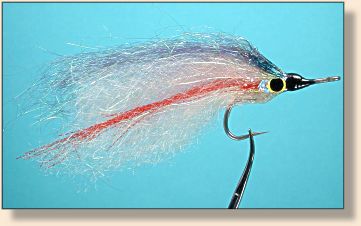
None of us caught a tarpon, but I did get a hit on my flash minnow while
fishing for tarpon. The fly wasn't a loss though; the barracudas loved it.
Jason Wood and I spent a whole morning taking turns catching barracudas
on nearly every cast with my flash minnow. When the fishing finally slowed
down around noon, Jason took the tattered fly as a souvenir. It was a
good day.
We didn't catch all the fish we wanted to catch, but we probably caught more
than we deserved. A new fly was born and tested with good results. I learned
that the Shwapf doesn't catch everything, but it does catch a lot of things.
I also learned that a landlubber from South Dakota can tie saltwater patterns
and even design one if he wants to.
Don't be afraid to tie your own flies for saltwater, even if you've never fished the
salt before. They aren't that hard to tie and the fish don't care who tied the fly
as long as it looks and fishes right. Hopefully, this article and the pictures will
help you with that last part. ~ Al Campbell
|





















